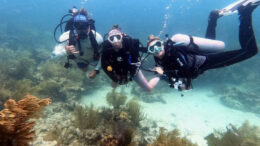Coral reefs support vibrant marine ecosystems, stimulate tourism and fishing industries, and protect shorelines from tropical storms and erosion. But reefs around the globe have been hit hard by pollution, overfishing and climate change, which is causing increasingly frequent and severe coral bleaching. Scientists predict severe bleaching on 99% of the world’s reefs within this century unless we reduce greenhouse gas emissions. Saving coral reefs requires major systemic changes — dramatic cuts in energy consumption, switching to renewable energy, managing overfishing and pollution, and restoring target reefs.
Restoration efforts have now become a priority for many scientists. This series looks at some of those efforts.
Early on a June morning, a group of 10 people dressed in shorts and flipflops gathers in a classroom at the Coral Restoration Foundation Exploration Center in Key Largo, Florida. We have come from Virginia, Maryland, Georgia, Texas, and just down the road to help save Florida’s coral reefs.
The 360-mile-long Florida reef is the third largest in the world. But since the 1970s, nearly 90% of its corals have died due to climate change, hurricanes, disease and human development. Reefs around the world are suffering from similar threats, and we’re just some of the thousands of volunteers joining scientists, government and non-government agencies, and private companies fighting to stop this loss.
As scuba divers, we take it personally.
“This loss has happened in my lifetime,” says Sage Morningstar, the foundation intern leading today’s volunteer training. Others of us remember diving the Florida reef years ago or hearing about its former glory from those who did. The foundation created its public dive program for people like us in 2017, and since then more than 4,000 volunteers have participated.
View this post on Instagram
Corals reproduce both sexually and asexually, the latter through fragmentation — when a piece breaks off, reattaches to the reef, and grows a new colony. The Coral Restoration Foundation uses fragmentation to grow corals in seven underwater nurseries along the South Florida coast, each containing hundreds of underwater structures called Coral Trees. Teams build the trees in a nearby facility, put them in the water, and attach about 60 small fragments. The corals grow for six to nine months, then are tagged, taken to a restoration site, and attached to a living reef through a process called outplanting. The nurseries now are self-sufficient, meaning fragments for new growth come from corals already there.
Five of the foundation’s restoration sites — Carysfort Reef, Horseshoe Reef, Sombrero Reef, Looe Key and Eastern Dry Rocks — are also part of Mission: Iconic Reefs, an ambitious effort by NOAA to restore seven Florida reefs (the other two are Cheeca Rocks and Newfound Harbor). Other parties involved are Mote Marine Laboratory and Aquarium, The Florida Aquarium, The Nature Conservancy, Reef Renewal and the National Marine Sanctuary Foundation.
The project totals 3 million square feet of restoration. It’s not just about planting more corals, but the most resilient corals, Florida Keys National Marine Sanctuary superintendent Sarah Fangman explained in a webinar in early 2021.
While some have criticized the agency for launching this mission while the threats continue, we can’t afford to wait. “Natural recovery can’t happen fast enough,” Fangman stressed during the webinar. “Yes, we have to address temperature stress, water quality, and other threats to give this system a chance, but restoration helps it along while we’re fixing those things.”
The morning training session complete, our group heads to the dive shop. But then Mother Nature steps in, sending a storm that cancels the trip. Disappointment shows in every face; each of us was excited about doing something meaningful today, contributing in however small a way to the reefs.
The plan had called for us to board the dive boat and go to the Tavernier Coral Nursery to clean some of the 500 trees standing in the sandy bottom there under about 30 feet of water.
Groves of the trees create an orderly grid that covers 1.5 acres, each grove containing a different species. In the one we were to clean, fragments of endangered staghorn coral hang like ornaments on the spindly Charlie Brown-ish tree structures. Volunteers use brushes to remove algae from monofilament line that holds each fragment and small chisels to scrape the stuff from the branches and trunks of the coral trees. On a healthy reef, but to a lesser extent in this nursery setting, herbivorous fish species like parrotfish keep algae in check, lest it grow over and kill corals by smothering them or blocking the sunlight.
One section of the nursery is a sort of genetic ark, holding hundreds of coral genotypes — the complete set of an individual organism’s genes, including variations.
“Biodiversity is primary,” says Morningstar. “We have genotypes here that no longer exist in the wild.” That genetic diversity makes it more likely that at least some of the corals survive if something happens on the reef, such as high temperatures or disease. It’s a key component of outplanting efforts.
Out next stop was to be Craysfort Reef, to plant staghorn corals that have grown big enough to venture from the nursery. On these dives, the crew hits the water first, schlepping milk crates of fragments, small hammers, and containers of epoxy. Volunteers follow and buddy teams are assigned to a tagged section of reef. Each measures a hammer’s length from an existing coral fragment, cleans three saucer-sized spots on the reef, applies epoxy, and attaches the new fragments at the three points. Proper attachment is critical, as the corals must survive the incessant action of normal waves and the more forceful waves of storms.
So, although volunteers are encouraged to attach as many corals as possible during the timed dive, the goal is quality, not quantity. The foundation team checks each planting and teams work outward in a circular fashion. This pattern allows the corals to grow together and fuse into one large colony. (Because the fragments come from the same original coral, they grow together rather than competing for space, as unrelated corals do.)
Working underwater has unique challenges and divers say outplanting can be quite frustrating. Surging ocean waters move you back and forth at this shallow depth, and you must control your buoyancy to avoid damaging any corals. Each scrape of the hammer moves your body. Fish attracted by the stirred-up algae get in the way. Most people use up their air faster than they would on a recreational dive. But the frustration pales against the importance of the task.
After these dive trips, volunteers scatter to the various attractions of the Keys, but work continues for the foundation team. The staff creates and maintains the nurseries, conducts regular outplanting dives on their own, and leads public outreach events and dives. They also monitor survival of individual outplants and the effect of restoration efforts on the larger ecosystem. Monitoring now is done primarily via a technique called photomosaic, which uses software to stitch together multiple photographs and create a map of a restoration site.
“With photomosaics, we are able to see survival and growth of all our outplants, not just a select sample,” Morningstar says. The technique, which several published studies have validated, also reduces the time spent on monitoring corals, freeing up more time for planting them.
Since 2012 Coral Restoration Foundation has outplanted more than 220,000 corals (nearly 13,500 of those by volunteers) representing more than 365,000 square feet of habitat. The foundation also ticked off another important indicator of success: the first-ever spawning of nursery-raised corals in the wild.
View this post on Instagram
“Making babies is hard, especially for corals,” Morningstar says, adding that spawning is a clear sign of reef health.
While scuba divers and residents of the Florida coast have an obvious stake in this effort, coral loss affects almost everyone. The annual economic value of the world’s coral reefs is an estimated $9.9 trillion — two times that of tidal marshes and wetlands and seven times more than tropical forests. This value comes from the role of reefs in supporting 25% of all marine life, providing food and livelihoods for coastal residents, underpinning tourism, and protecting shorelines and structures from wave energy, especially during storms. Coral reef services benefit more than a billion people around the world. That makes restoration an important investment.
“Restoring a tenth of the world’s coral reefs would cost in the range of $4 to $8 trillion,” writes marine biologist Juli Berwald in her book Life on the Rocks. “A 2014 study of coral reefs valued their ecosystem services at $362,000 per hectare per year. Frank Mars said it required a $250,000 investment to restore a hectare of reef. So, you’ve got a return on investment of about 1.5 with coral reefs.” Restoring coral reefs is “a reasonable investment,” she concludes. (The method developed in Indonesia by Mars — yes, the candy company — uses six-legged rebar structures populated with coral fragments and networked together on the ocean floor; Mars says 8 divers could construct a basketball court-sized ‘reef’ in 3 hours.)
It remains true that unless and until humans stop doing the things that harm reefs, these restoration efforts are a bit like trying to empty the sea with a bucket. But again, wait and it may be too late. And there’s more that people can do.
“Put pressure on policymakers around the world,” suggests Jessica Levy, the foundation’s director of restoration strategy. “Support policies, candidates and leaders who support climate response. We need this to be a political issue, unfortunately. Make ocean friendly choices in your daily life, choosing sustainable seafood and reducing plastic consumption and your carbon footprint. It all contributes, but we really need to ensure that governments take action.”
And show up in Key Largo, too, if you can. The corals need all hands on deck. I plan to make a return trip — and hope for better weather.
Previously in The Revelator:
![]()


